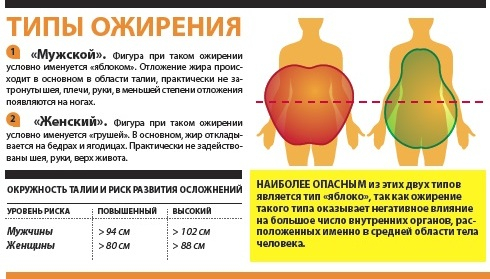Despite its widespread use in clinical practice and epidemiological studies, body mass index (BMI) as an indicator of obesity is often criticized for its limited ability to distinguish between adipose tissue from others (i.e. muscle, bone), as well as fluid mass in the body.
Individuals within the same BMI category can have significant differences in the amount and distribution of body fat.
Learn in detail in the article on estet-portal.com about the criteria for excess weight and the relationship between the type of obesity and diseases of the cardiovascular system
Anatomical differences in obesity types
There is growing evidence that body fat in abdominal obesity (truncal, android, upper obesity) is a strong predictor of adverse metabolic disorders (e.g. insulin resistance) that increase the risk of developing cardiovascular disease (CVD) , whereas an increase in the amount of adipose tissue in the lower body, as in gluteal-femoral obesity (lower, gynoid type), does not affect the development of metabolic disorders. This evidence highlights the potential importance of adipose tissue distribution in the development of cardiometabolic disease.
Follow us on Instagram!
Postmenopausal women are subject to metabolic changes, which are partly due to the transfer and accumulation of adipose tissue from the subcutaneous to the intra-abdominal visceral depot.
Such metabolic disorders are associated with an increased risk of CVD in a population with normal BMI.
However, studies evaluating the accumulation of adipose tissue and its relationship with the risk of developing CVD in people with a normal BMI in postmenopausal women are still lacking. Therefore, American scientists decided to investigate the role of the type of obesity in the development of CVD in postmenopausal women with normal BMI.
CV risk studies in different types of obesity
At baseline, 11,393 participants underwent full-body dual-energy x-ray absorptiometry scans at three designated clinical centers (Birmingham, Tucson/Phoenix, and Pittsburgh), among which there were 3,464 participants with a normal BMI (18.5 to
Clinical studies on the effectiveness of intermittent fasting

Researchers evaluated both absolute (in kilograms) and relative measures of body fat. Relative fat mass measures were the percentage of total body fat mass or regional fat mass in relation to total body mass.
Higher percentages of adipose tissue in both the trunk and hips have been associated with lower physical activity, higher BMI scores, use of statins and non-steroidal anti-inflammatory drugs in daily life.
Participants with abdominal obesity had higher systolic and diastolic blood pressure and were more likely to be treated for hypertension. Participants with the highest percentage of adipose tissue in the thigh area – lower type of obesity, were less likely to smoke and less likely to have diabetes, but more likely to take hormonal drugs.
Health analysis results for different types of obesity
A high percentage of adipose tissue distribution with visceral obesity was associated with an increased risk of CVD, while individuals with a high percentage of adipose tissue in the lower body, on the contrary, did not have a tendency to CVD. Participants who had a large amount of adipose tissue in the trunk area and a small amount in the lower extremities had a more than three times increased risk of CVD.
Interval Training – the gold standard in the management of obese patients
Large waist circumference (abdominal type of obesity) is associated with an increased risk of CVD death in patients with normal BMI. Although all participants in the American study had a relatively small waist circumference (mean 73 cm), only a small proportion (about 2%) had a large circumference (> 88 cm), however, a large amount of adipose tissue in the visceral zone is associated with an increased risk of developing CVD.

Summarizing the results of the research, scientists argue that women with normal BMI in postmenopausal women who have more adipose tissue in the visceral zone (upper type of obesity) and lower distribution in the hip area have an increased risk of developing CVD, because in The study included 2683 postmenopausal women with normal BMI (18.5 to
How to Boost Your Metabolism: The Secret to a Boosted Metabolism
These findings highlight the important role of adipose tissue distribution and type of obesity in the development of CVD. Therefore, it is so important for a practitioner to pay attention not only to one indicator of BMI, but to have an integrated approach to various types of obesity, as part of the prevention of serious complications from the cardiovascular system.
Ghrelin: lose weight by leaps and bounds







Add a comment